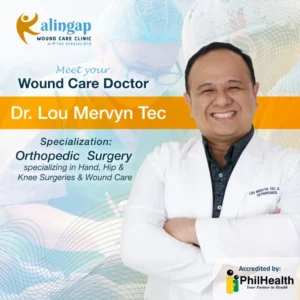Understanding the Role of a Wound Doctor
A wound doctor is a medical specialist focused on the diagnosis, treatment, and management of wounds that are difficult to heal. Unlike general practitioners who treat a broad range of conditions, wound doctors possess specialized knowledge and skills to handle chronic wounds such as diabetic ulcers, pressure sores, and surgical wounds that do not heal normally. These doctors evaluate wounds in-depth, looking beyond the surface to identify underlying issues that impede healing, such as poor circulation, infection, or diabetes-related complications. Their expertise extends to both acute injuries and chronic wounds that linger for weeks or months, affecting quality of life. By developing personalized treatment plans, wound doctors aim to accelerate healing, reduce infection risk, and prevent further complications. Their work often involves coordinating with other healthcare providers to ensure a comprehensive approach. Understanding when and why to seek a wound doctor can be critical for individuals facing complex wound challenges.
Common Causes of Wounds That Require Specialized Care
Wounds that require attention from a wound doctor often arise from various causes. Traumatic injuries, such as cuts, burns, or accidents, can sometimes lead to wounds that fail to heal properly, especially if infection or tissue damage is extensive. Surgical wounds that don’t heal as expected may also need specialized care, as complications like infections or poor blood flow can slow recovery. Chronic conditions like diabetes and vascular diseases commonly result in wounds that heal slowly or become persistent, especially diabetic foot ulcers. Immobility in hospitalized or elderly patients can lead to pressure sores, which often require expert intervention due to their depth and risk of infection. Other factors like poor nutrition, smoking, and compromised immune systems also affect wound healing and can necessitate the help of a wound doctor. Understanding the causes helps patients and caregivers recognize when wounds might benefit from specialized treatment. Early identification of these risks can prevent minor wounds from becoming severe medical issues.
Diagnostic Tools and Techniques Used by Wound Doctors
Wound doctors utilize a variety of diagnostic tools to properly assess and treat wounds. Visual inspection and accurate measurement of the wound area provide essential information about the wound’s size, depth, and condition. Imaging techniques such as ultrasound or X-rays help evaluate underlying tissue damage or detect bone infections in more severe cases. Laboratory tests are important to identify the presence of infection, including cultures to determine the exact bacteria causing problems. Some wound doctors use advanced diagnostic tools like wound biopsies or digital wound imaging to gain deeper insights into the wound’s biology and healing progress. These technologies enable tailored treatment plans that address specific challenges unique to each wound. Regular reassessment using these diagnostic methods ensures that treatment adjustments are made promptly. Accurate diagnosis is key to preventing complications and promoting faster healing.
Treatment Approaches in Wound Care
The treatment methods applied by a wound doctor depend heavily on the type and severity of the wound. Cleaning the wound and removing dead tissue, known as debridement, is a fundamental step that prepares the wound bed for healing. Different dressings serve different purposes—hydrocolloid dressings maintain moisture, foam dressings offer cushioning, and alginate dressings absorb excess fluid, each chosen according to the wound’s characteristics. Antibiotic and antimicrobial therapies help control or prevent infections, which can severely hinder healing if left untreated. More advanced treatments may include negative pressure wound therapy, which uses suction to promote tissue growth, or skin grafts for wounds that require new tissue to close effectively. Hyperbaric oxygen therapy is another option that delivers pure oxygen to tissues, stimulating healing for certain chronic wounds. The wound doctor monitors the patient’s progress closely, adjusting treatment protocols to maximize results. A combination of these approaches, customized to the individual, often yields the best healing outcomes.
Importance of a Multidisciplinary Approach
Managing complex wounds often requires collaboration between a wound doctor and other healthcare professionals. Nurses trained in wound care assist with regular dressing changes and monitoring for signs of infection. Physical therapists support mobility improvements and circulation, which are vital for wound healing, especially for pressure ulcers. Nutritionists play a key role, as proper nutrition supplies the body with the building blocks necessary for tissue repair. Patient education is a crucial element of this multidisciplinary approach, empowering patients and caregivers to manage wounds effectively at home and avoid behaviors that may delay healing. Preventive strategies, such as regular repositioning for bedridden patients or managing blood sugar levels in diabetics, help reduce the risk of wound recurrence. Communication among the care team ensures that all aspects of the patient’s health are addressed. This integrated approach promotes a comprehensive healing environment that goes beyond treating the wound itself.
When to See a Wound Doctor
Recognizing when a wound requires the expertise of a wound doctor can make a significant difference in healing outcomes. Wounds that show no signs of improvement after two to four weeks of standard care should prompt a specialist consultation. Warning signs include increased redness, swelling, foul odor, discharge, or severe pain, all of which may indicate infection or other complications. Patients with diabetes or vascular disease should be especially vigilant, as even minor wounds can become serious without specialized attention. Early intervention by a wound doctor can prevent chronicity, reduce hospitalizations, and lower the risk of amputations in extreme cases. During a consultation, patients can expect a thorough assessment, diagnostic testing, and the development of a detailed care plan tailored to their wound’s unique needs. Referrals to a wound doctor typically come from primary care providers or hospital teams but can also be initiated directly by patients aware of persistent wound issues. Timely access to specialized wound care is critical for restoring health and functionality.
Innovations and Future Trends in Wound Care
Advancements in medical technology continue to improve outcomes in wound care. Emerging treatments like regenerative medicine, including stem cell therapy, hold promise for repairing damaged tissues more effectively than traditional methods. Researchers are also developing new biomaterials for wound dressings that promote faster healing and reduce infection risk. Telemedicine is expanding access to wound doctors, especially for patients in remote or underserved areas, allowing for virtual assessments and follow-up care. Artificial intelligence tools are being explored to analyze wound images and provide predictive insights about healing trajectories. These innovations aim to reduce healing times, lower healthcare costs, and improve patient quality of life. As research progresses, wound doctors are increasingly able to offer personalized treatment plans based on the latest evidence and technology. Staying informed about these advancements helps patients and caregivers make educated decisions regarding wound management options.
Frequently Asked Questions (FAQ)
What conditions qualify for treatment by a wound doctor?
Wound doctors treat a range of conditions, including chronic wounds like diabetic foot ulcers, pressure sores, venous ulcers, surgical wounds that don’t heal, and traumatic injuries that are slow to recover.
How long does wound healing usually take with specialized care?
Healing time varies based on the wound type, patient health, and treatment method. Some wounds may heal in a few weeks, while chronic wounds could take several months with proper care.
Are wound doctors covered by insurance?
Most insurance plans cover wound care services, especially when referred by a primary care physician or specialist. Coverage specifics vary, so checking with your insurer is recommended.
Can wound doctors help with diabetic foot ulcers?
Yes, diabetic foot ulcers are among the most common wounds treated by wound doctors. Specialized care helps prevent infection, promote healing, and reduce the risk of amputation.
How can I prevent wounds from becoming chronic?
Early treatment, good hygiene, managing underlying conditions like diabetes, proper nutrition, and following wound care instructions can help prevent wounds from becoming chronic.




